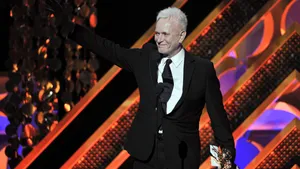Justice Sandra
Day O'Connor, the first woman appointed to the Supreme
Court and a key swing vote on issues such as abortion and
the death penalty, said Friday she is retiring.
The news of
O'Connor's retirement was met with extreme disappointment by
national gay rights groups and activists. "Justice
O'Connor's retirement is a clarion call to every
American that our rights are in grave danger," said
Joe Solmonese, president of the gay rights
group Human Rights Campaign. "During her time on the
court, Justice O'Connor became increasingly supportive
of equal rights for all Americans. Her concurring
opinion in Lawrence v. Texas recognized the
basic equality of gay, lesbian, bisexual, and
transgender people under law. In opinions in First Amendment
cases she protected the constitutional wall between
church and state. Justice O'Connor also voted to
uphold the right to choose and to preserve
universities' right to promote diversity."
O'Connor, a
75-year-old native of El Paso, Texas, said she expects to
leave before the start of the court's next term in October,
or whenever the Senate confirms her successor. There
was no immediate word from the White House on who
might be nominated to replace O'Connor.
It's been 11 years since the last opening on the
court, one of the longest uninterrupted stretches in
history. O'Connor's decision gives President Bush his
first opportunity to appoint a justice. "This is to
inform you of my decision to retire from my position as an
associate justice of the Supreme Court of the United
States, effective upon the nomination and confirmation
of my successor," she said in a one-paragraph letter
to Bush. "It has been a great privilege indeed to have
served as a member of the court for 24 terms. I will leave
it with enormous respect for the integrity of the
court and its role under our constitutional structure."
Bush made a statement in the White House
Rose Garden regarding her resignation. He did not,
however, announce a nominee to succeed her.
O'Connor's retirement comes amid longtime
speculation that the aging court would soon have a
vacancy. But speculation has most recently focused on
Chief Justice William H. Rehnquist, 80, who
is suffering from thyroid cancer. Rehnquist has
offered no public clue as to his plans.
The White House has refused to comment on any
possible nominees or whether Bush would name a woman
to succeed O'Connor. Ruth Bader Ginsburg is the only
other woman among the current justices.
Possible replacements include Atty.
Gen. Alberto R. Gonzales and federal courts of
appeals judges J. Michael Luttig, John Roberts, Samuel
A. Alito Jr., Michael McConnell, Emilio Garza, and James
Harvie Wilkinson III. Others who have been mentioned
are former solicitor general Theodore Olson, lawyer
Miguel Estrada, and former deputy attorney general Larry
Thompson, but Bush's pick could be a surprise choice not
well known in legal circles.
Another prospective candidate is Edith Hollan
Jones, a judge on the fifth U.S. circuit court of
appeals who was considered for a Supreme Court vacancy
by President Bush's father.
O'Connor's appointment in 1981 by President
Ronald Reagan, quickly confirmed by the Senate, ended
191 years of male exclusivity on the high court. She
wasted little time building a reputation as a hardworking
moderate conservative who emerged as a crucial power broker
on the nine-member court. O'Connor often lines up with
the court's conservative bloc, as she did in 2000 when
the court voted to stop Florida presidential ballot
recounts sought by Al Gore and effectively called the
election for Bush. As a "swing voter," however, O'Connor
sometimes votes with more liberal colleagues.
Perhaps the best example of her influence is the
court's evolving stance on abortion. She distanced
herself both from her three most conservative
colleagues, who say there is no constitutional underpinning
for a right to abortion, and from more liberal
justices for whom the right is a given.
O'Connor initially balked at letting states
outlaw most abortions, refusing in 1989 to join four
other justices who were ready to reverse the landmark
1973 decision that said women have a constitutional right to
abortion. Then in 1992, she helped forge and lead a
five-justice majority that reaffirmed the core holding
of the 1973 ruling. Subsequent appointments secured
the abortion right. Commentators called O'Connor the
nation's most powerful woman, but O'Connor pooh-poohed the
thought. "I don't think it's accurate," she said in an
Associated Press interview.
O'Connor was diagnosed with breast cancer in
late 1988 , and she underwent a mastectomy. She missed
just two weeks of work. That same year she had her
appendix removed. For years O'Connor exhibited an
involuntary nodding of her head, but she said she never had
it diagnosed. The movement, while not constant, was an
up-and-down motion similar to that made by someone
nodding in the affirmative.
O'Connor remained the court's only woman until
1993, when, much to O'Connor's delight and relief,
President Bill Clinton appointed Ginsburg. The
enormity of the reaction to O'Connor's appointment had
surprised her. She received more than 60,000 letters
in her first year, more than any one member in the
court's history.
"I had no idea when I was appointed how much it
would mean to many people around the country," she
once said. "It affected them in a very personal way.
People saw it as a signal that there are virtually
unlimited opportunities for women. It's important to parents
for their daughters, and to daughters for themselves."
At times, the constant publicity was almost
unbearable. "I had never expected or aspired to be a
Supreme Court justice. My first year on the court made
me long at times for obscurity," she once said. On the
court, O'Connor generally favored states in disputes with
the federal government and for enhanced police powers
challenged as violative of asserted individual rights.
In 1985 she wrote for the court as it ruled that
the confession of a criminal suspect first warned
about his rights may be used as trial evidence even if
police violated a suspect's rights in obtaining an
earlier confession. O'Connor wrote the 1989 decision that
struck down as an unconstitutional form of affirmative
action a minority set-aside program for construction
projects in Richmond, Va. In 1991 she led the court as
it ruled in its first-ever decision on rape-shield laws that
states may under some circumstances ban evidence that a
defendant and his alleged victim previously had
consensual sex.
O'Connor once described herself and her eight
fellow justices as nine firefighters. "When [someone]
lights a fire, we invariably are asked to attend to
the blaze. We may arrive at the scene a few years
later," she said.
O'Connor was 51 when she joined the court to
replace the retired Potter Stewart. A virtual unknown
on the national scene until her appointment, she had
served as an Arizona state judge and before that as a member
of her state's legislature. A fourth-generation
Arizonan, she had grown up on a sprawling family ranch.
The woman who climbed higher in the legal
profession than had any other member of her sex did
not begin her career auspiciously. As a top-ranked
graduate of Stanford's prestigious law school, class of
1952, O'Connor discovered that most large law firms
did not hire women. One offered her a job as a
secretary. Perhaps it was that early experience that shaped
O'Connor's professional tenacity. She once recalled a
comment by an Arizona colleague: "With Sandra
O'Connor, there ain't no Miller time." "I think that's
true," confessed the justice, whose workweek most
often extended beyond 60 hours.
But she played tennis and golf well, danced
expertly with her husband, John, and made frequent
appearances on the Washington party circuit.
O'Connor was embarrassed in 1989 after
conservative Republicans in Arizona used a letter she
had sent to support their claim that the United States
is a "Christian nation." The 1988 letter, which prompted
some harsh criticism of O'Connor by legal scholars, cited
three Supreme Court rulings in which the nation's
Christian heritage was discussed. O'Connor said she
regretted the letter's use in a political debate. "It
was not my intention to express a personal view on the
subject of the inquiry," she said.
O'Connor's name was linked in 1985 with that of
Washington Redskins football star John Riggins when at
a formal dinner he was heard to tell the justice, who
was sharing his table, "Loosen up, Sandy baby."
Shortly thereafter, the women who participated with O'Connor
at an 8 a.m. daily exercise class presented her with a
T-shirt that proclaimed, "Loosen Up at the Supreme
Court." The O'Connors have three sons: Scott, Brian,
and Jay. (AP)





































































Charlie Kirk DID say stoning gay people was the 'perfect law' — and these other heinous quotes